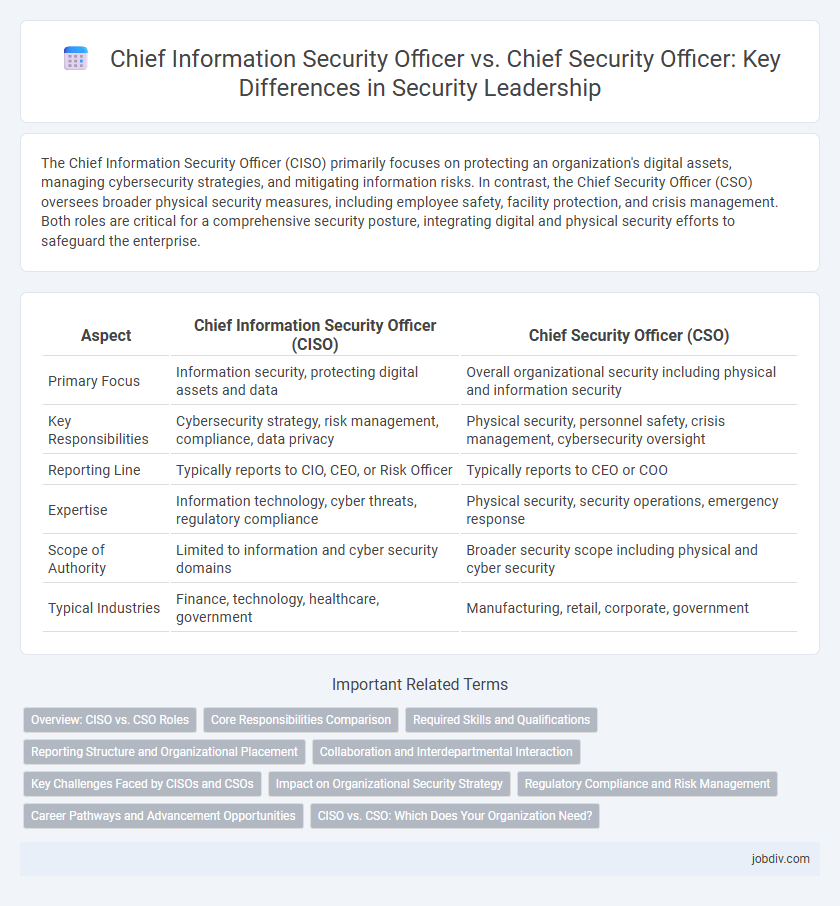The Chief Information Security Officer (CISO) primarily focuses on protecting an organization's digital assets, managing cybersecurity strategies, and mitigating information risks. In contrast, the Chief Security Officer (CSO) oversees broader physical security measures, including employee safety, facility protection, and crisis management. Both roles are critical for a comprehensive security posture, integrating digital and physical security efforts to safeguard the enterprise.
Table of Comparison
| Aspect | Chief Information Security Officer (CISO) | Chief Security Officer (CSO) |
|---|---|---|
| Primary Focus | Information security, protecting digital assets and data | Overall organizational security including physical and information security |
| Key Responsibilities | Cybersecurity strategy, risk management, compliance, data privacy | Physical security, personnel safety, crisis management, cybersecurity oversight |
| Reporting Line | Typically reports to CIO, CEO, or Risk Officer | Typically reports to CEO or COO |
| Expertise | Information technology, cyber threats, regulatory compliance | Physical security, security operations, emergency response |
| Scope of Authority | Limited to information and cyber security domains | Broader security scope including physical and cyber security |
| Typical Industries | Finance, technology, healthcare, government | Manufacturing, retail, corporate, government |
Overview: CISO vs. CSO Roles
The Chief Information Security Officer (CISO) primarily focuses on safeguarding an organization's digital assets, overseeing cybersecurity strategies, risk management, and compliance with data protection regulations. In contrast, the Chief Security Officer (CSO) has a broader remit, encompassing physical security, corporate safety policies, and crisis management alongside information security governance. Both roles collaborate to create a comprehensive security framework, but the CISO specializes in digital information security while the CSO addresses all aspects of organizational safety.
Core Responsibilities Comparison
The Chief Information Security Officer (CISO) primarily focuses on protecting an organization's information assets through cybersecurity strategies, risk management, and compliance with data protection regulations. In contrast, the Chief Security Officer (CSO) oversees broader security concerns, including physical security, personnel safety, and crisis management. Both roles collaborate to ensure comprehensive security, but the CISO targets digital threats while the CSO addresses overall organizational security risks.
Required Skills and Qualifications
Chief Information Security Officers (CISOs) require expertise in cybersecurity frameworks, risk management, and regulatory compliance, often holding certifications like CISSP or CISM. Chief Security Officers (CSOs) need a broader skill set encompassing physical security, crisis management, and corporate security strategy, frequently supported by a background in law enforcement or military experience. Both roles demand strong leadership, communication skills, and the ability to align security initiatives with organizational goals.
Reporting Structure and Organizational Placement
The Chief Information Security Officer (CISO) typically reports to the Chief Information Officer (CIO) or directly to the CEO, emphasizing cybersecurity and information risk management within the IT department. The Chief Security Officer (CSO) often holds a broader role encompassing physical security, corporate security, and risk mitigation, reporting to the CEO or Chief Operating Officer (COO) to address overall enterprise security strategy. Organizational placement reflects their focus: the CISO is integrated into technology and information governance, while the CSO operates at the intersection of security functions across the entire organization.
Collaboration and Interdepartmental Interaction
The Chief Information Security Officer (CISO) primarily focuses on protecting digital assets through cybersecurity strategies, requiring close collaboration with IT, risk management, and compliance teams to implement effective security protocols. The Chief Security Officer (CSO) oversees broader organizational security, including physical security and crisis management, necessitating interaction with facilities, human resources, and legal departments. Effective security governance depends on seamless collaboration between the CISO and CSO, fostering integrated risk mitigation across both cyber and physical domains.
Key Challenges Faced by CISOs and CSOs
Chief Information Security Officers (CISOs) primarily confront challenges related to cyber threats, including data breaches, ransomware attacks, and securing digital assets against evolving malware, while ensuring regulatory compliance like GDPR and HIPAA. Chief Security Officers (CSOs) face broader physical security challenges encompassing workplace safety, access controls, and crisis management, often coordinating with law enforcement during security incidents. Both roles demand strategic risk assessment and incident response capabilities tailored to their distinct domains, but CISOs focus more on technological vulnerabilities whereas CSOs prioritize physical and operational security risks.
Impact on Organizational Security Strategy
The Chief Information Security Officer (CISO) specializes in cybersecurity, shaping policies to protect data integrity, confidentiality, and IT infrastructure against digital threats. In contrast, the Chief Security Officer (CSO) oversees both physical and information security, ensuring a comprehensive strategy that mitigates risks across all organizational assets. Together, they align security initiatives to strengthen the company's resilience against evolving threats and regulatory challenges.
Regulatory Compliance and Risk Management
The Chief Information Security Officer (CISO) primarily focuses on regulatory compliance related to information security standards, such as GDPR, HIPAA, and ISO 27001, ensuring that IT systems adhere to data protection laws and policies. In contrast, the Chief Security Officer (CSO) oversees broader risk management encompassing physical security, corporate policies, and overall enterprise risk mitigation strategies. Both roles collaborate to develop comprehensive risk management frameworks that address cybersecurity threats and regulatory requirements across the entire organization.
Career Pathways and Advancement Opportunities
Chief Information Security Officers (CISOs) typically advance through roles in IT security, cybersecurity analysis, and risk management, gaining specialized expertise in protecting digital assets. Chief Security Officers (CSOs) often progress from physical security, operational risk, or corporate security management, overseeing broader organizational safety measures. Career pathways for CISOs emphasize technical credentials like CISSP or CISM, while CSOs benefit from leadership experience across multiple security domains, offering distinct advancement opportunities depending on organizational focus.
CISO vs. CSO: Which Does Your Organization Need?
A Chief Information Security Officer (CISO) primarily focuses on protecting an organization's digital assets, overseeing cybersecurity strategies, risk management, and compliance with data protection regulations. In contrast, a Chief Security Officer (CSO) manages broader physical and corporate security, including facilities, personnel safety, and crisis response. Organizations with significant cyber risk and data protection needs benefit more from a CISO, while those requiring comprehensive physical and information security integration may prioritize a CSO.
Chief Information Security Officer vs Chief Security Officer Infographic

 jobdiv.com
jobdiv.com